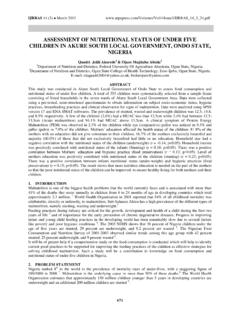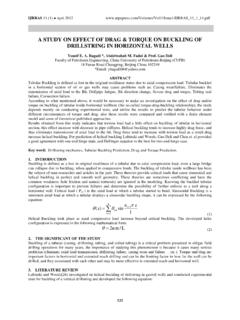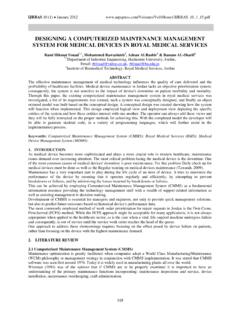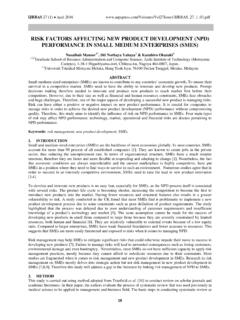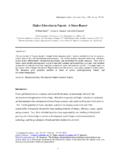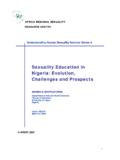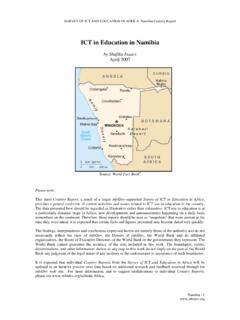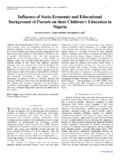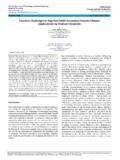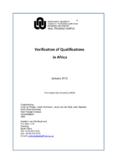Transcription of ASSESSMENT OF NUTRITIONAL STATUS OF …
1 IJRRAS 14 (3) March 2013 ASSESSMENT OF NUTRITIONAL STATUS OF UNDER FIVE. CHILDREN IN AKURE SOUTH LOCAL GOVERNMENT, ONDO STATE, nigeria . Quadri Jelili Akorede1 & Ojure Mujitaba Abiola2. 1. Department of Nutrition and Dietetics, Federal University Of Agriculture Abeokuta, Ogun State, nigeria . 2. Department of Nutrition and Dietetics, Ogun State College of Health Technology, Ilese-Ijebu, Ogun State, nigeria . E-mail: ABSTRACT. This study was conducted in Akure South Local Government of Ondo State to assess food consumption and NUTRITIONAL STATUS of under five children. A total of 355 children were systematically selected from a sample frame consisting of listed households in the seven wards of Akure South Local Government Area. Data were collected using a pre-tested, semi-structured questionnaire to obtain information on subject socio-economic STATUS , hygiene practices, breastfeeding practices and clinical observation for signs of malnutrition.
2 Data were analyzed using SPSS. version 17 and ENA SMAT softwares. The prevalence of stunted, wasted and underweight children was , , and respectively. A few of the children ( ) had a MUAC less than while had between (Acute malnutrition) and had MUAC above A clinical symptom of Protein Energy Malnutrition (PEM) was observed in of the children while eye (conjunctiva) pallor was noticed in and pallor (palm) in of the children. Mothers' education affected the health STATUS of the children; of the mothers with no education did not give colostrum to their children, of the mothers exclusively breastfed and majority ( ) of those that did not exclusively breastfeed had little or no education. Household size had a negative correlation with the NUTRITIONAL STATUS of the children (underweight) (r = ; p< ). Household income was positively correlated with NUTRITIONAL STATUS of the infants (Stunting) (r = ; p< ).
3 There was a positive correlation between Mothers' education and hygienic practice (food preservation) (r = ; p< ). Level of mothers education was positively correlated with NUTRITIONAL STATUS of the children (stunting) (r = ; p< ). There was a positive correlation between infants NUTRITIONAL STATUS (under-weight) and hygienic practices (food preservation) (r = ; p< ). The result shows that more nutrition education is needed on the part of the mothers so that the poor NUTRITIONAL STATUS of the children can be improved, to ensure healthy living for both mothers and their children. 1. INTRODUCTION. Malnutrition is one of the biggest health problems that the world currently faces and is associated with more than 41% of the deaths that occur annually in children from 6 to 24 months of age in developing countries which total approximately million. 1 World Health Organization in 2001 reported that 54% of all childhood mortality was attributable, directly or indirectly, to malnutrition.
4 Sub-Saharan Africa has a high prevalence of the different types of malnutrition, namely stunting, wasting and Feeding practices during infancy are critical for the growth, development and health of a child during the first two years of life 3 and of importance for the early prevention of chronic degenerative diseases. Progress in improving infant and young child feeding practices in the developing world has been remarkably slow due to several factors like poverty and poor hygienic conditions 4. The 2003 NDHS shows that 38 percent of nigeria children under the age of five years are stunted, 29 percent are underweight, and percent are wasted 5. The Nigerian Food Consumption and Nutrition Survey of 2001-2003 observed similar trends among this age group with 42 percent stunted, 25 percent underweight, and 9 percent wasted 6. It will be of greater help if a comprehensive study on the food consumption is conducted which will help to identify current good practices to be supported for improving the feeding practices of the children as effective strategies for solving childhood malnutrition.
5 Such a study will be a contribution to knowledge on food consumption and NUTRITIONAL STATUS of under five children in nigeria . 2. PROBLEM STATEMENT. nigeria ranked 8th in the world in the prevalence of mortality rates of under-fives, with a staggering figure of 189/1000 in 2008 7. Malnutrition is the underlying cause in more than 50% of these The World Health Organization estimates that approximately 150 million children younger than 5 years in developing countries are underweight and an additional 200 million children are stunted 9. 671. IJRRAS 14 (3) March 2013 Akorede & Abiola ASSESSMENT of NUTRITIONAL STATUS Malnutrition contributes to nigeria 's current health problems (morbidity and mortality) in several ways. Undernutrition remains a devastating problem in many developing countries affecting over 815 million people causing more than one- half of child , 11 Although, WHO, UNICEF and nigeria 's National breastfeeding policy recommended that infants be exclusively breastfed from birth to 6 months and continue breastfeeding to 24.
6 Months and beyond for optimal survival, growth development unfortunately only 17% of infants under six months of age are exclusively breastfed in nigeria 6. The poor breastfeeding and inadequate complementary feeding explained the protein energy malnutrition level in children as they grow older. The Specific objectives are as follows: - To assess the socio economic STATUS of subjects parent in Akure South LGA. - To determine the anthropometric indices of under-five children in the study area. - To determine the usual dietary intake of the subjects and assess the adequacy. - To report any clinical signs of malnutrition like Parlor and Goitre observed in the subjects. 3. METHODOLOGY. The LGA (Akure South Local Government) was randomly selected among urban local governments in Ondo state, nigeria . Simple random sampling was used to choose seven wards that were considered for the study, The wards were Gbogi/isikan I, Gbogi/isikan II, Ilisa ,Oda, Oke-aro, Oshodi/isolo and Owode ward.
7 A systematic random sampling was used to ensure spread among respondents, by taking household at regular interval beginning from the oba's house. Methods of data analysis Appropriate analytical techniques were used depending on the variables or the characteristics being considered. Descriptive and inferential statistical techniques were used for quantitative data including socio-economic and demographic information, anthropometry, food intake to generate frequencies and percentages using statistical package for social sciences (SPSS) Version The anthropometric data obtained were used to determine the mean weight for age, mean weight for age, mean weight for height, and mean MUAC were compared with WHO. Reference standard (2007). 4. RESULTS. Household demographic characteristics The age distribution of the household head was depicted on Table 1. The age range of 30-40 years had the highest ( ) percentage of respondents; while age groupings 40-49years, 20-29 years and above 50 years had , and respectively.
8 The distribution of mothers' age shows that the age range of 21-30years had the highest ( ) percentage and 31- 40 years had while the lowest percentage ( ) came from ages less than 20years. The age distribution of children (month) shows that the age range of 0-6months had the highest ( ) percentage while 31-59months ( ) was higher than those between 7-12months ( ) and the least was 13-30months ( ). The family size of the household was shown on Table 1, The breakdown is as follows, household with 1-4 members ( ) had the highest percentage while 5-8sized and 9-12sized household had and respectively. The mothers educational STATUS shows that, those with secondary education had the highest percentage of , followed by those that had post secondary education ( ) while those that have only primary education was and respondents with no formal education was Table 1: Socio demographic characteristics of the respondents n=355.
9 Variable Frequency Percentage (%). Age group (Years). Household Head 20 29 54 30 39 200 40 49 86 50 above 15 Total 355 100. Mother 10 20 9 21 30 208 672. IJRRAS 14 (3) March 2013 Akorede & Abiola ASSESSMENT of NUTRITIONAL STATUS 31 40 121 41 above 17 Mothers educational STATUS No formal education 29 Primary education 66 Secondary education 165 Tertiary education 95 Children age (months). 0 6 145 7 12 61 13 30 25 31 59 124 Total number of household member 1 4 210 5 8 121 9 12 24 Total 355 100. Figure 1 shows that the major energy source of most households in Ondo town was PHCN, of the household used electricity generated by Power holding company of nigeria as the primary source of energy while use personal generator as the source of electricity and about % of the respondents did not have electricity in their house and the least is rural electricity which is just As for the Primary occupation of the household, Figure 2 shows that of the household head were civil servants and the artisan were respondents while trading made a percentage of Farming was and only was fishermen.
10 Considering the estimated annual income of household depicted on figure 3, of all the respondents, those that their annual income was below 100 thousand naira had the highest percentage ( ) while those that earn between 100. 199, 99 thousand naira came up with followed by 200 299, 99 thousand naira with and the respondent that earn between 300 399, 99 thousand naira annually had percentage of and between 400 499, 99 thousand naira made up a percentage of Primary source of water of the household as shown on Figure 4, indicated that larger percentage of respondents in Ondo town used deepwell ( ) while borehole followed deepwell with and used pipe borne water while the spring/river has the lowest percentage of 100 Percentage 50. No electricity 0 Personal generator No Personal Rural electricity electricity generator Rural PHCN. electricity PHCN. 673. IJRRAS 14 (3) March 2013 Akorede & Abiola ASSESSMENT of NUTRITIONAL STATUS Figure 1: major energy sources of most households Farming Trading Civil servant Artisan Fishermen others Figure 2: Primary occupation of the household Head < 100 thousand 100 - 199,99.
